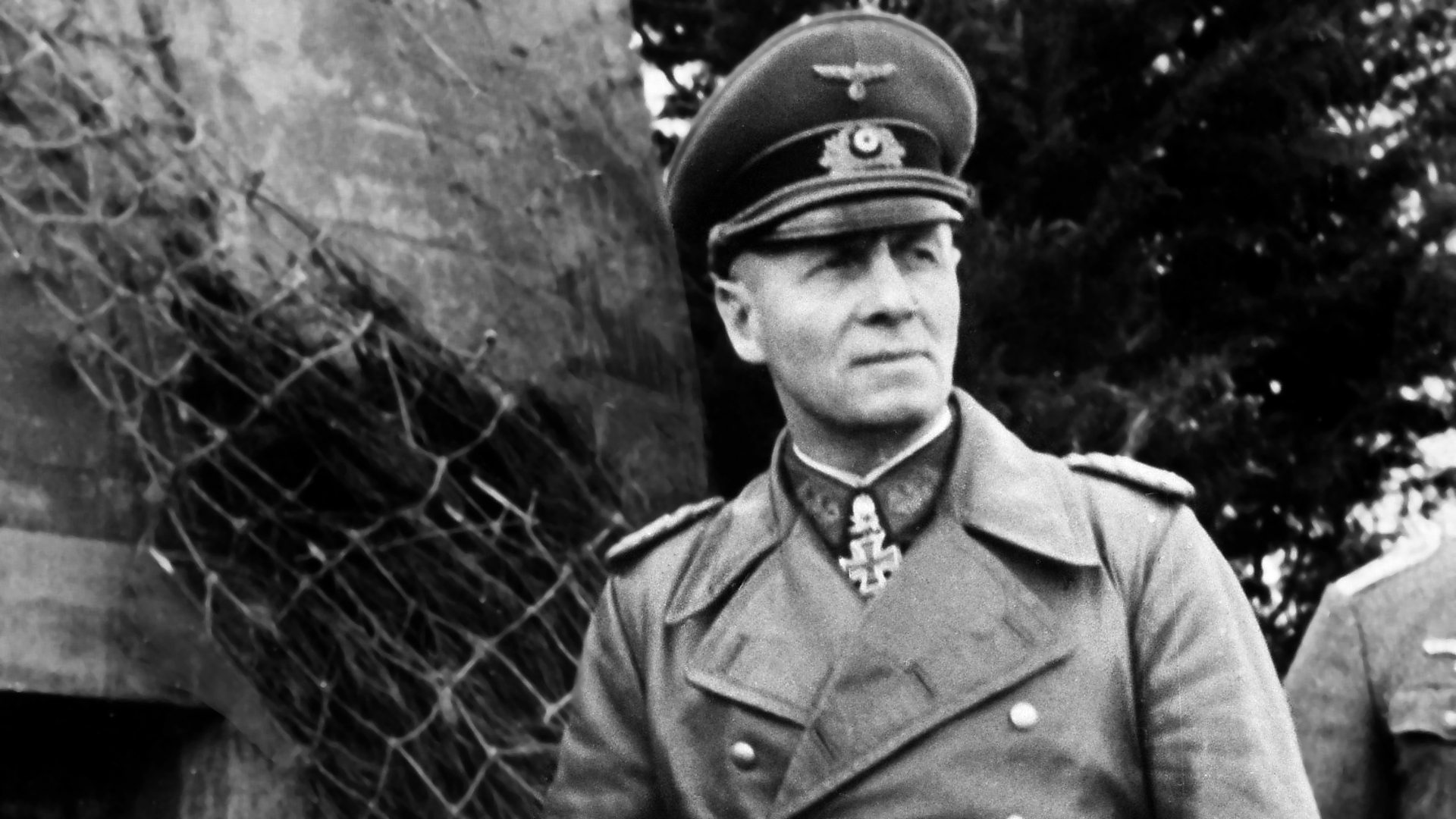Johannes Erwin Eugen Rommel was Born November 15, 1891 in Heidenheim an der Brenz; October 14, 1944 in Herrlingen) was a German career officer, from 1942 with the rank of Field Marshal.
Rommel joined the Württemberg Army in 1910 and was decorated for bravery during World War I. He was then accepted into the Reichswehr and the Wehrmacht. In 1937 his book Infantry Attacks was published, in which he processed his wartime experiences and military strategies. During World War II he served as commander of the 7th Armored Division in France from February 1940. His deployment as commander of the German Africa Corps and the Panzer Army Africa in North Africa, with whose troops he advanced to El-Alamein in July 1942, brought him great popularity at home and open respect abroad. He later served as Commander-in-Chief of Army Group B again in France, where he was wounded in an air raid on July 17, 1944. After the July 20, 1944 assassination attempt, Adolf Hitler accused him of involvement and forced him to commit suicide.
Rommel had an ambivalent relationship to National Socialism and the Resistance. While his turn into an opponent of Hitler is accepted in research, his involvement in the assassination of July 20, 1944 remains controversial. Recent research indicates that Rommel “not only knew about the July 20 coup, but supported it and went over to the conspiratorial camp”.
Erwin Rommel Private Life
Rommel was born in 1891 as the second of four children of the high school teacher and later rector Erwin Rommel and his wife Helene, née Luz (from Luz since 1880), in Heidenheim an der Brenz (Bahnhofstraße 5) and grew up in Aalen. From 1900 to 1908 he attended the Latin school there, then from 1908 to 1910 the Realgymnasium Schwäbisch Gmünd (today ‘s Parler-Gymnasium). In 1910 he joined the Württemberg Army.
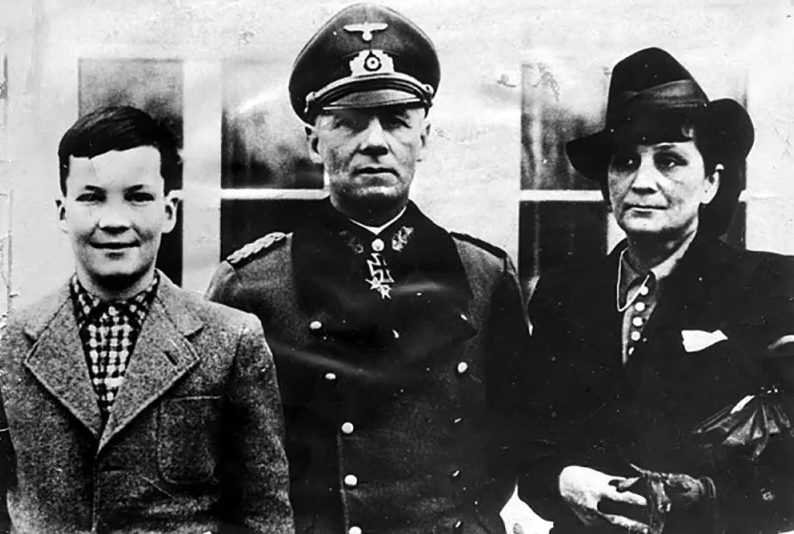
Rommel With Family
From 1912 Rommel had a love affair with Walburga Stemmer from Weingarten, who gave birth to their daughter Gertrud in December 1913. In November 1916 Rommel married Lucie Maria Mollin (1894–1971), whom he had met in 1911 during a war school course in Danzig. Rommel’s wife was a niece of the Polish priest Edmund Roszczynialski in Neustadt in West Prussia near Danzig. This applied after the German conquest of Poland as missing. At his wife’s request, Rommel inquired about the persecuted uncle. He was stalled by the bureaucracy and had to tell her a year later that nothing had been found out. Roszczynialski was arrested by the Gestapo on October 30, 1939 and was shot just under two weeks later, on November 11 or 12, near Cewice, probably in the Piaśnic forest.
The illegitimate daughter Gertrud grew up with her grandmother. Rommel and his wife took care of the girl, who was passed off as Rommel’s niece. In December 1928 her son Manfred Rommel was born, who later became a CDU politician and mayor of Stuttgart. Walburga Stemmer died in October 1928, probably by suicide. Gertrud’s children, Rommel’s grandsons, settled in the Allgäu.
In October 1943 the Rommel family moved to Herrlingen from Wiener Neustadt. She moved into a building there, known as the “Breitenfels House” or “Martin-Buber House”, which was part of the Jewish rural school that was dissolved in the spring of 1939. This educational institution, headed by the Berlin pedagogue Hugo Rosenthal, was founded in 1926 by Anna Essinger, who had fled to England with her pupils in the autumn of 1933. The residents of the Jewish retirement home set up in these buildings in mid-1939 were deported in 1941/42.
The Propaganda Ministry made up a different life story for Rommel, which was printed in the weekly newspaper Das Reich in April 1941. In it he was portrayed as a worker’s son who was one of the first SA leaders to have acquired National Socialist convictions from a personal relationship with Hitler. Rommel himself complained about this false CV.
Erwin Rommel Military Career
German Empire and First World War
Rommel, who was interested in aviation and actually wanted to apply for a job at the Zeppelin works in Friedrichshafen, was given the choice of becoming either a teacher or an officer by his father. Rommel chose a military career. After being rejected by the artillery and the engineers, he joined the infantry regiment “König Wilhelm I.”(6th Württemberg) No. 124 in Weingarten, Upper Swabia, on July 19, 1910 as a flag cadet. Between March and November 1911 he completed the obligatory course at the War Schoolin Gdansk.
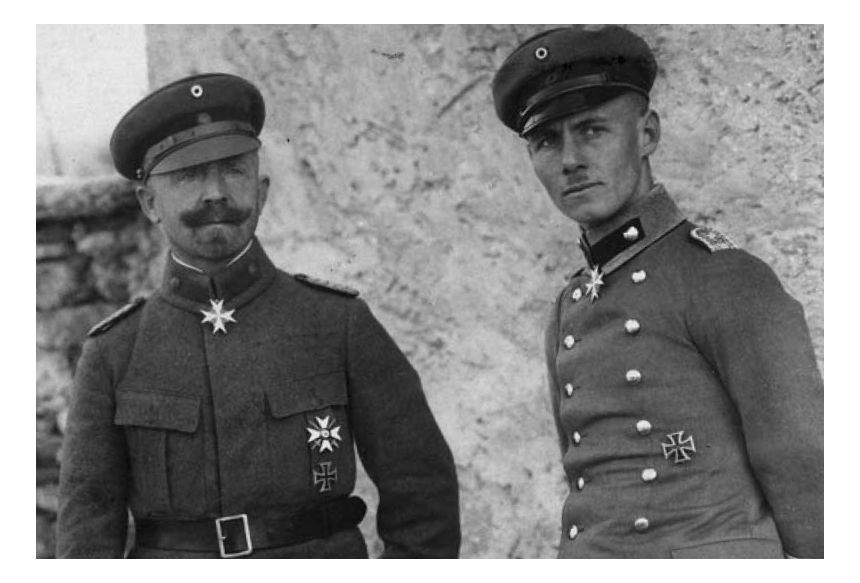
Rommel In WW1
On January 27, 1912, Erwin Rommel was promoted to lieutenant and was now working on recruit training in Weingarten. On March 1, 1914, he was assigned to the 4th Battery of the 49th Field Artillery Regiment in Ulm for five months. When World War I began on August 1, 1914, he fought with his old regiment in the Longuyon area, on the Meuse and west of Verdun. In September 1914 he received the Iron Cross, Second Class, followed in January 1915 by the Cross, First Class, and the Knight’s Cross of the Württemberg Military Order of Merit. On September 18, 1915 he was promoted to Oberleutnant.
From October 1915 Rommel was under Theodor Sproesser company commander in the Württemberg mountain battalion, which first fought in trench warfare in the High Vosges and then in 1916 on the Romanian front. At the end of September 1917, Rommel’s battalion was transferred to the Isonzo front and took part in mountain warfare. Rommel’s participation initially succeeded in breaking into the Kolovrat position and in the Battle of Karfreit at the end of October 1917 in storming the Matajur. In mid-November Rommel took part in the capture of Longaronepart. In December Rommel was awarded the Order Pour le Mérite for his service without the customary prior award of the House Order of Hohenzollern. Before the award, Rommel had complained that the success at the Matajur had initially been credited to an officer from another unit. In his book Infantry Attacks, published in 1937, Rommel gave a detailed account of his involvement in World War I.
In January 1918 Rommel became an orderly officer in the Württemberg General Command z. b. V. 64 in Friedrichshafen, where he was promoted to captain on October 18. After the end of the war he returned to Weingarten around Christmas 1918 with the 7th company of the 124th Infantry Regiment.
Weimar Republic
The Versailles Treaty stipulated that the army strength of the Reichswehr could not exceed 100,000 men. Rommel was spared the mass layoffs: he was able to remain in the military.
In March 1919, Rommel led the Württemberg Security Company 32 in Friedrichshafen. On June 25, 1919, he became company commander in the Schützen-Regiment “Alt-Württemberg”(1st Württemberg) No. 25. On October 18, he was sworn in to the new Weimar Constitution. In 1919 and 1920 Rommel was deployed against insurgents in Lindau, in Münsterland and in Westphalia. In 1924 he was on the staff of the 2nd Battalion of the 13th Infantry Regiment, from 1925 to 1929 he was chief of the 4th (MG) company of this regiment.
From October 1929 to September 1933, Rommel was head of inspection and teacher at the Infantry School in Dresden ‘s Albertstadt, today ‘s Army Officers School. On April 1, 1932 he was promoted to Major.
Nazi era and World War II
Like many other members of the Reichswehr, Rommel, although never a party member, had great sympathy for the NSDAP. He therefore welcomed the seizure of power by the National Socialists, since in his opinion a clear leader was needed again after years of political unrest. This was all the more true when Adolf Hitler revised the Versailles Treaty demanded and also enforced. Hitler’s upgrading, expansion and modernization of the military met with the approval of the soldiers, whose social standing had suffered after the First World War, as had the military’s central position in the state. However, Rommel and other officers were uneasy about the role played by the competitive SA under the new regime. The elimination of the SA in June 1934 was therefore also viewed positively by Rommel. The rearmament of the Wehrmacht promoted by the Nazi state implied better career prospects for officers.
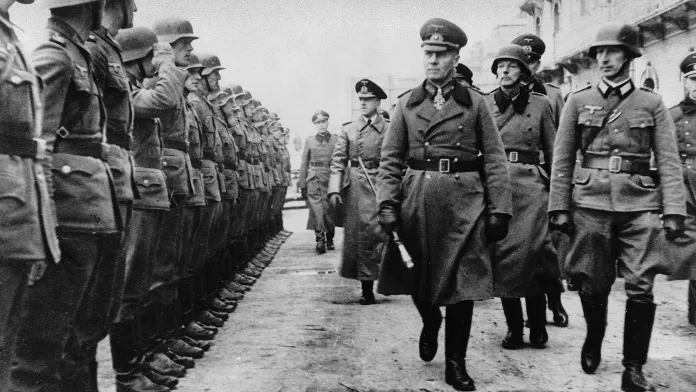
Rommel Inspecting Troops
Rommel first met Hitler in late September 1934 when he was visiting the 5th Division ‘s autumn maneuvers in the Swabian Jura. On October 1, 1933, Rommel was appointed commander of the III. Battalion (“Goslarer Jäger”) of the 17th Infantry Regiment was transferred to Goslar, where he remained until mid-January 1935. In 1934 Rommel’s book for training combat tasks for platoons and companies: A manual for officer instruction was published. This book was printed in five editions with revisions and title changes until 1945.
In mid-October 1935, Rommel, who had been promoted to lieutenant colonel on January 1, 1935, became head of the course at the new war school in Potsdam, which he left again in November 1938. During this time he wrote his book Infanterie attack, which had a circulation of approximately 400,000 until 1945. From February 21, 1937 to August 31, 1938, Rommel was also a part-time Wehrmacht liaison officer to the Reich Youth Leader. At the beginning of October 1937 he was promoted to colonel.
As a (peace-time) course leader, Rommel had a mobilization assignment as commander of the Führer accompanying battalion. He was first used as such at the NSDAP Nazi Party Rally in Nuremberg in September 1936, as well as during the annexation of Austria in March 1938 and shortly thereafter during the invasion of the Sudetenland in October 1938. Rommel was subsequently employed from November 10, 1938 to August 22 1939 briefly commanded the war school in Wiener Neustadt.
During the destruction of Czechoslovakia and the invasion of Memelland in March 1939, Rommel, as commander of the escort battalion, was also commander of the Führer’s headquarters.
Campaign in Poland and France
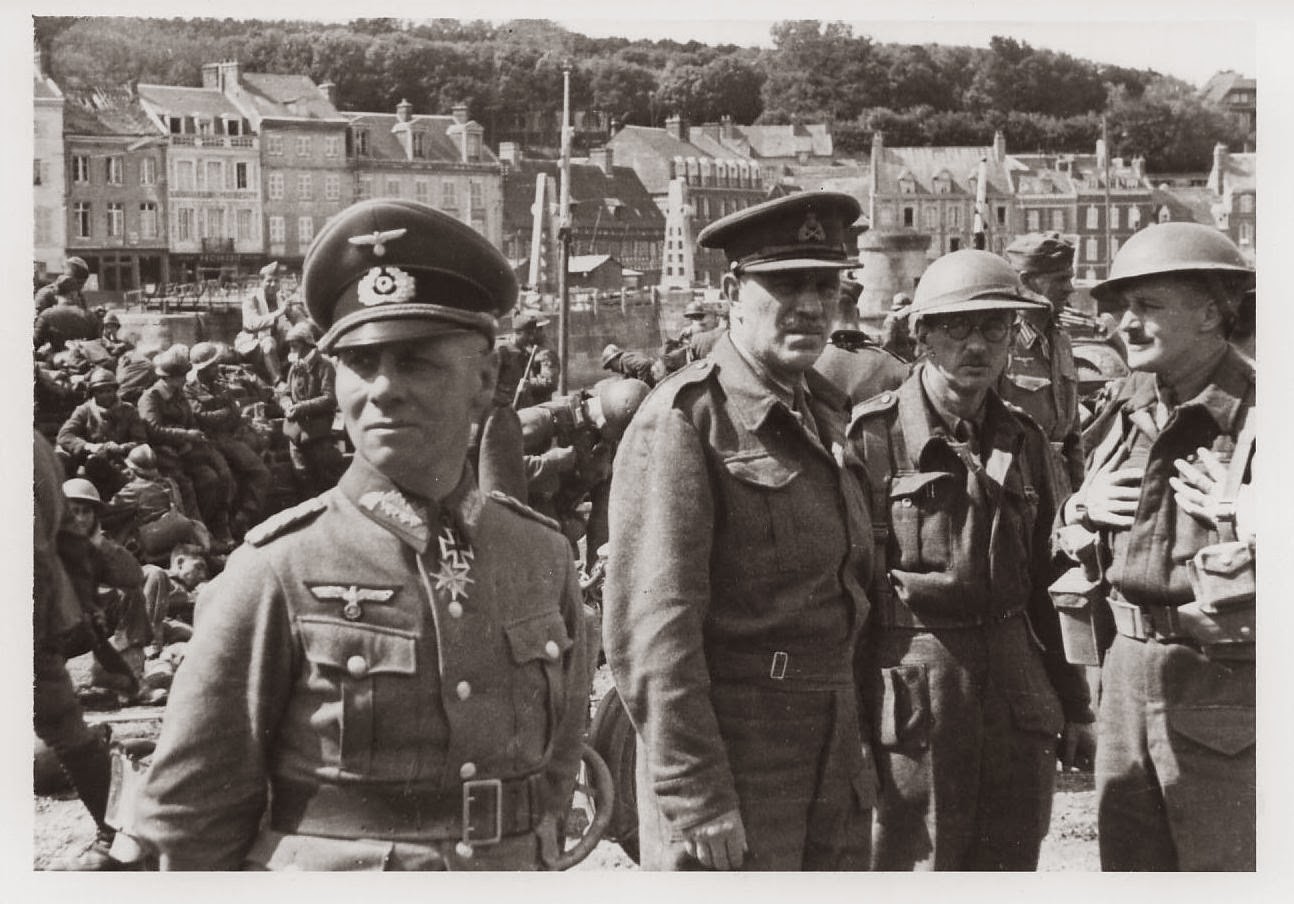
Rommel With Captured British Generals
From August 23, 1939 to February 14, 1940, Rommel was again in command of the Führer Headquarters during the invasion of Poland, which marked the beginning of World War II. Hitler promoted him to Major General retroactively to August 1, 1939.
After the invasion of Poland, Hitler complied with Rommel’s desire to lead an armored division by appointing him commander of the 7th Panzer Division at Bad Godesberg in February 1940. Up until then, Rommel had had no practical experience in commanding tank formations, but he proved to be successful in the “Yellow Case” in France with his idiosyncratic front leadership. The unpredictability and speed of his operations irritated not only his opponents but also the German High Command. It earned his division the nickname “Ghost Division”. Rommel’s band met at Dinantacross the Meuse, broke through the extended Maginot Line and advanced to the La Bassée Canal. On May 27, 1940, he was awarded the Knight’s Cross of the Iron Cross.
Deployed in Libya and Egypt
In September 1940, Italy had launched an invasion of the British-allied Kingdom of Egypt from Italian Libya. The British counter-offensive from early December 1940 collapsed the Italian 10th Army and resulted in the complete loss of Cyrenaica by 8 February 1941. Under this impression, Benito Mussolini and Hitler agreed in January on direct German support in Libya. In addition to additional air force units, this was to consist of a tank corps with two divisions.
Rommel, who had been promoted to Generalleutnant in January 1941, was personally selected for command by Hitler against the opposition of Army Commander-in-Chief Walther von Brauchitsch. On February 12, 1941, Rommel reached Tripoli as part of Operation Sonnenblume and was appointed commander of German troops in North Africa effective February 15. His assignment was to assist Italy in the defense, prevent a British advance on Tripoli and, by April 20, develop a plan for the reconquest of Cyrenaica to submit. As such, the German Afrika Korps was subordinate to the Italian supreme commander on the ground, but the German leadership had ensured that the corps could only be deployed as a complete unit, giving Rommel tactical and operational freedom, which he used extensively. As early as April 3, 1941, he was to come into conflict with General Italo Gariboldi when, against his will, he turned a reconnaissance thrust into Ajdabiya into a counter-offensive. With its strategic planning, the Italian operations staff threatened to “get caught in the middle of Rommel’s initiatives”.
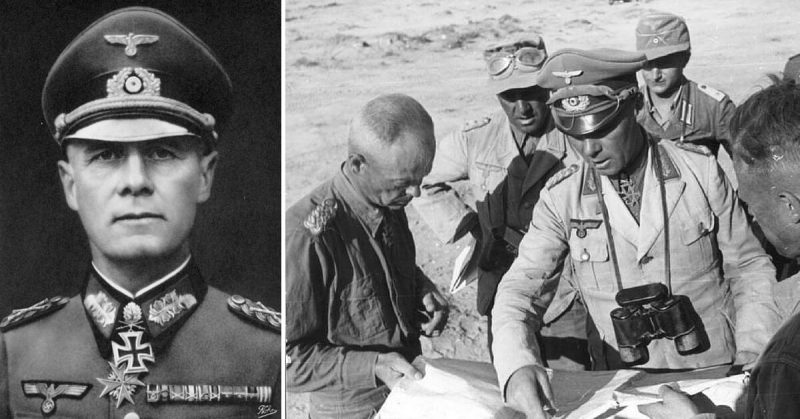
Rommel In Africa
Rommel only awaited the arrival of the first of his two divisions: with the first detachments of the 5th Light Motorized Division (motorized) that had arrived in Africa, later reorganized into the 21st Panzer Division, Rommel advanced rapidly eastwards along the Mediterranean coast and reached Sirte on February 16, while the British General Staff assumed that “considerable time would elapse before a serious counter-offensive could be launched from Tripoli”. The area of El Agheila, where the British had broken off the advance of Operation Compass on February 8, was reached by Rommel on February 22. Two days later the first battle with a British unit took place thereKing’s Dragoon Guards.
On March 20, 1941, during a visit to Germany, Rommel received the Oak Leaves of the Knight’s Cross from Hitler as the second soldier in the army for his service in France and Libya. On March 24, during a reconnaissance raid, he surprisingly succeeded in occupying El Agheila, although the Army High Command had repeatedly instructed him to wait for the arrival of the 15th Panzer Division. Having broken the Enigma encryption, the British overheard Rommel’s repeated wait orders and awaited no further action from his 5th Light Division. Therefore, he succeeded in further advances and, with the support of two Italian divisions transferred to Africa, by April 10, he was able to recapture Cyrenaica up to the fortress of Tobruk and encircle the city. His subsequent attacks on Tobruk failed (cf. Siege of Tobruk). Not least the transfer of British forces from the Middle East Command to Greece because of the Balkan campaign had made Rommel’s success possible.
A further advance was not possible without the capture of Tobruk. An attempt was made by Rommel in early May after the arrival of the missing 15th Panzer Division. Rommel and his troops managed to repel a British counter-offensive in mid-May and another major Allied counter-offensive in mid-June (Operation Battleaxe).
Overall, the German mission in North Africa was characterized by supply problems. The main reason for this was the preferential supply of German troops in the war against the Soviet Union, which had begun in June 1941 with Operation Barbarossa. Resupply deliveries for the ports of Tripoli and Benghazi suffered greatly from British naval and air raids, as the supply routes and dates were known to the British through the decoding of the Enigma. In addition, the German conquest of Malta, the base of the supply hindrance, was postponed again and again. Rommel did not take sufficient notice of the resulting operational limitations or did not include them in the further offensive conduct of operations.
In July 1941 Rommel was promoted to General der Panzertruppe. In September he was appointed commander of Panzer Group Afrika, which included all – mostly Italian – Axis forces in Cyrenaica. Another attack by Rommel on Tobruk, planned for November 23, 1941, was preceded by the British Crusader offensive on November 18. By December 31, Rommel’s troops were forced to withdraw beyond the El Agheila line.
On January 20, 1942, Rommel was the first soldier in the army to be awarded the Knight’s Cross with Oak Leaves. With Panzer Group Africa being upgraded to Panzer Army Africa, Rommel was now army commander-in-chief from January 22, 1942. At the end of January, Rommel undertook the second Cyrenaica offensive, during which the British 1st Armored Division was overrun and the 8th Army was pushed back to Gazala / Bir Hacheim by February 7th. Rommel was then promoted to Generaloberst on February 1, 1942.
On May 26, Rommel began the Gazala Offensive. While at times on the brink of total defeat, he managed to defeat the entire British armored force off Tobruk in mid-June. Finally, on June 21, 1942, Rommel’s army captured the city. For this he was promoted to Field Marshal the following day. At that time, at the age of 50, he was the youngest holder of this rank in the Wehrmacht.
In July 1942 the first Battle of El Alamein took place, which ended in a stalemate. On the British side, Claude Auchinleck was replaced in mid-August by General Alexander as Commander-in-Chief Middle East and by General Bernard Montgomery as Commander-in-Chief of the 8th Army. A second attempt by Rommel to break through the Allied positions was prevented at the Battle of Alam Halfa in late August/early September. At this point Rommel was already suffering from stomach problems, reported to the OKH on August 22 that he was ill and hit Generaloberst Heinz Guderian As his successor. Two days later, however, he was informed that no suitable tank general was currently available. A contingency plan called for Albert Kesselring to assume supreme command of the African theater of war, with Walther Nehring as supreme commander of the Panzer Army and Gustav von Vaerst as commander of the Afrika Korps. Rommel then replied that while he now felt healthy enough to direct the operation, he would need a longer break home afterwards. The Axis attack on Alexandria and then Cairowas stopped with it. From the end of September to the end of October Rommel stayed in Germany for health reasons. He was represented by General of the Armored Corps Georg Stumme.
On October 23, the Allies under General Montgomery began their counteroffensive, forcing Rommel to retreat in the Second Battle of El Alamein. Despite significant losses, Hitler instructed Rommel in a standstill order on November 3 to use all means to avert defeat. Rommel, no longer believing in victory in North Africa, defied the order and withdrew his army after British troops under Montgomery broke through the lines at El Alamein. Finally, on 8 November 1942, British and American forces landed in French North Africa as part of Operation Torch.
Operation in Tunisia
After the retreat to Tunisia, the front in western Tunisia and in the east to the Libyan-Tunisian border came to a standstill. The British 8th Army halted its advance in front of the Mareth Line to allow its supplies to move up. Rommel used this window of opportunity. According to his plan, the British 1st Army should be encircled by an encirclement movement between the Tunisian border, Constantine and Bône. This led to the Battle of the Kasserin Pass. Although this battle was a tactical success, the strategic goal of destroying the Allied forces in Algeria and thus avoiding a two-front war was missed. This battle was Rommel’s last success in Africa. To Rommel’s detriment, there was no joint Axis supreme command in Tunisia, which made strategic goals more difficult, since both armies acted completely autonomously. While in the north the 5th Panzer Army under Hans-Jürgen von Arnim acted cautiously and hesitantly, Rommel’s southern army had to bear the brunt of the attack.
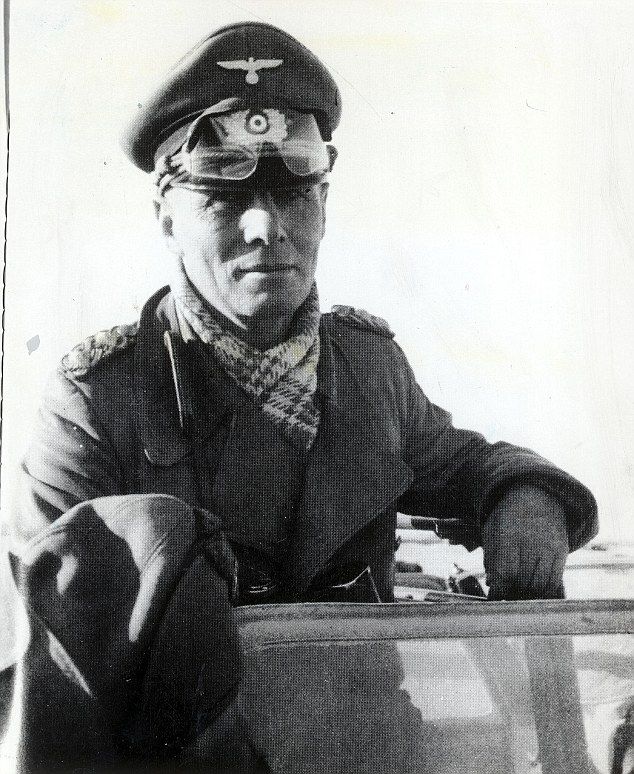
Romme In Africa
He created lasting memories for himself in the United States Army, since (among other things) the American 1st Armored Division suffered a bitter defeat in its first confrontation in modern mobile warfare, despite quantitative and qualitative superiority. The British historian Paul Kennedy describes the defeat of the American land forces at Kasserine as the “most humiliating defeat”(alongside the Battle of the Philippines) in the entire war.
On February 23, 1943, Rommel became Commander-in-Chief of Army Group Africa. When the defeat of the German troops was in sight, Rommel left Africa on March 6. Rommel, who was admired by the German population and used as a propaganda figure by the Nazi regime, should not be associated with the defeat. On March 11, Hitler awarded Rommel the Diamonds to the Knight’s Cross with Oak Leaves and Swords for his service in Africa. Rommel was the first soldier in the army to receive this exclusive award. Only after mid-May 1943 Rommel’s successor Colonel General Hans-Jürgen von Arnim near Tunissurrendered, the public learned that Rommel had already left Africa in March and received another award. Before that, because of Rommel’s disregard of orders, tensions had arisen between Hitler and Rommel for the first time, which only resolved when Rommel’s assessment of the inevitable defeat in North Africa was finally confirmed.
Overall, the successes in the African campaign brought Rommel great popularity at home and open respect abroad and the nickname “Desert Fox “.
Use in Italy
From May 20th to July 12th, 1943, Rommel headed a task force named after him, dealing with the preparations for German countermeasures when Italy was expected to leave the war. When the Allies landed on Sicily in Operation Husky in July, he was given supreme command of Army Group B on July 15. After Mussolini was deposed in July, the occupation of Italy began under Rommel’s command. While he led the troops in northern Italy, Albert Kesselring was in charge in southern Italy. Allied troops landed on the Italian mainland in September. The Cassibile ceasefire was announced on September 8th.
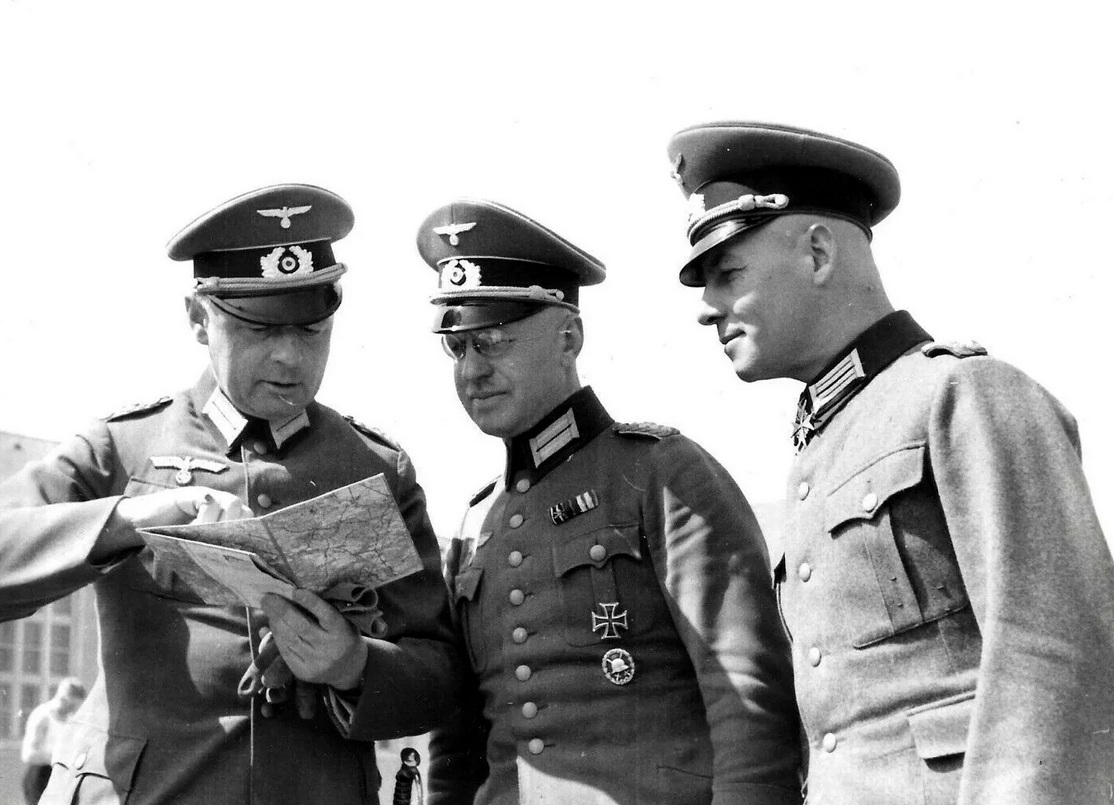
Rommel In Italy
On September 23, 1943, Rommel issued the directive:
“Any sentimental inhibitions on the part of the German soldier towards gangs belonging to Badoglio in the uniform of the former comrade-in-arms are completely inappropriate. Any of these fighting the German soldier has lost every right to mercy and must be treated with the harshness due to a rabble who suddenly turns their arms on their friend. This view must be accelerated and become common knowledge for all German troops.”
Contrary to the provisions of the Geneva Convention of 1929, around 1,070,000 disarmed Italian soldiers were declared as “military internees” and obliged to do forced labor (permissible for prisoners of war) in the German war economy (the Badoglio government only declared to Germany on October 13 under pressure of the Allies the war). Rommel’s order of October 1, 1943 read as follows:
“This war is a total war. Insofar as the men of Italy no longer have the opportunity to fight with arms for the freedom and honor of their fatherland, they have the duty to use their full working power in this fight.”
Use on the Atlantic Wall
In November 1943, Army Group B was transferred to France under Commander-in-Chief Rommel. Rommel was also tasked with supervising the defenses of the Atlantic Wall. In this function he was directly subordinate to Hitler and expanded the fortifications on the coast with assertiveness and organizational skills. His tactical creativity was shown, among other things, in the use of simple obstacles made of tree trunks against landing craft and cargo gliders. The soldiers called individually buried tree trunks “Rommel asparagus “.
In early January 1944, Rommel assumed command of all German troops north of the Loire. He was subordinate to the Commander-in-Chief West, Field Marshal Gerd von Rundstedt. Differences of opinion arose between him and Rommel as to where the Allied invasion would take place and how to most effectively combat it.
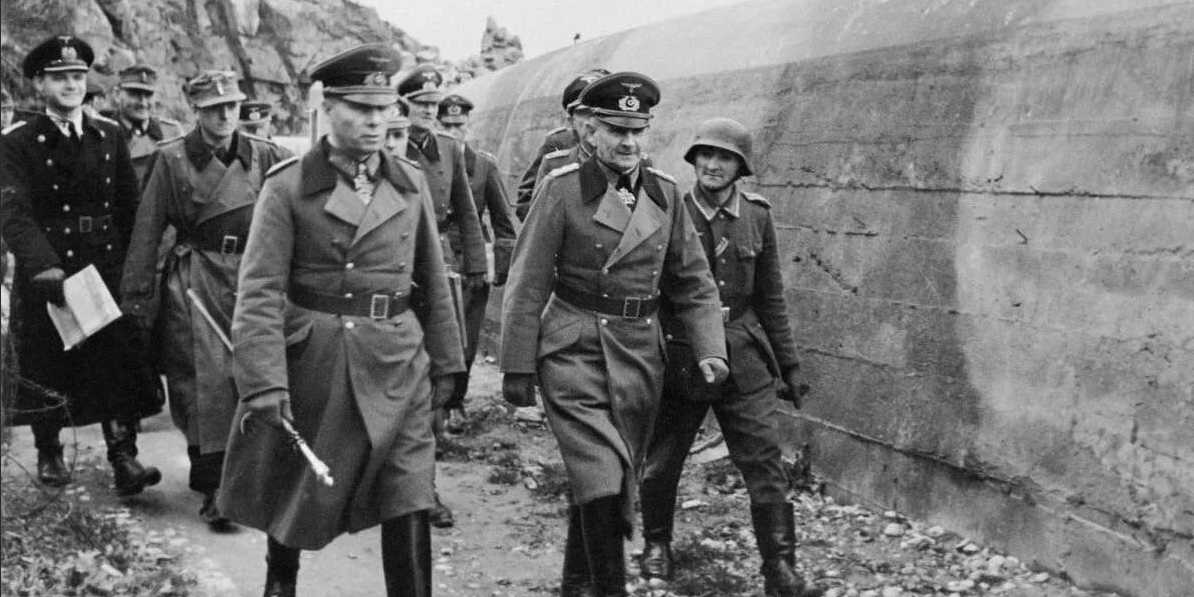
Rommel-Normandy
In March 1944, Rommel, like all other field marshals, signed a declaration of loyalty to Hitler, although he felt that this was unnecessary because, in his view, a soldier’s pledge of loyalty, once given, was permanent anyway. From June 4, Rommel was on a short vacation in southern Germany to celebrate his wife’s birthday. When the Allied invasion (D-Day) did take place, he returned to the front on June 6th. In personal discussions with Hitler in June 1944 as well as in his letter “Reviews on the Situation” of July 15, Rommel made it clear that he considered a victory for the German troops to be unlikely: “The troops are fighting heroically everywhere, but the unequal battle tends towards the end. In my opinion, it is necessary to draw the political conclusions from this situation.” His chief of staff, Hans Speidel, who was close to the resistance, was able to persuade Rommel to drop the word “political”. On July 17, Rommel was seriously wounded in a low -flying attack near Sainte-Foy-de-Montgommery and taken to the Luftwaffe hospital Bernay.. On August 1, he made his final appearance at a press conference in Paris to dispel rumors of his death in the foreign press. After resigning his supreme command of the army group, he stayed at his home in Herrlingen to rest.
Rommel and National Socialism
The question of Rommel’s attitude towards National Socialist ideology is difficult to answer and threatens to be obscured by the depiction of his military career and the myth associated with it. Although Rommel was never a member of the NSDAP, he accepted the establishment of the National Socialist system without objection and made a career for himself in the Wehrmacht.
The close relationship between Hitler and Rommel is repeatedly mentioned in the literature. Hitler personally encouraged Rommel’s career. As commander of the Führer’s headquarters, he found himself in close proximity to the dictator from an early stage. Both men are said to have respected each other and got along extremely well. Rommel was widely regarded as Hitler’s “favorite general”. According to Albert Kesselring, he had an “almost hypnotic influence” on Hitler. Goebbels noted in October 1942 after a conversation with Hitler:
“Rommel made a very deep impression on him Hitler. He has a solid ideology, is not only close to us National Socialists, but is a National Socialist ”
– Joseph Goebbels
Maurice Philip Remy points out that Rommel admired Hitler and the regime established by him and served him unquestioningly. However, this attitude should not be equated with a National Socialist conviction, especially since Rommel seems to have paid little attention to Nazi ideology. Rommel’s loyalty to Adolf Hitler is repeatedly emphasized in the literature and Rommel is described as a “convinced supporter” and “Hitler’s unconditional follower”. In a letter to his wife dated September 2, 1939, Rommel enthused: “It’s wonderful that we have this man.”
Hitler tried to bind Rommel to himself by showing him favors, such as personal talks or participation in important meetings. Rommel thanked him with admiration and obedience: “To find his Hitler’s recognition for my actions is the highest thing I could wish for.”together often at intimate meetings. This trust is my greatest joy, more so than my rank as general.” In some cases Rommel seems to have overestimated the importance of his person for Hitler.
During his deployment in North Africa, tensions arose between Rommel and Hitler for the first time. Rommel, who had always admired Hitler’s military understanding, had to recognize that Hitler made his assessments of the situation according to different criteria than himself. Unusually sharply, he condemned Hitler’s actions in relation to North Africa: “It became clear to me that Adolf Hitler did not want to see the true situation and was emotionally opposed to what his mind had to tell him.”There were further tensions when Rommel after D-Day In mid-1944 he came to the conclusion that the war could no longer be won and asked Hitler to draw conclusions from this assessment of the situation. However, he misjudged the character of the war started by the National Socialists.
The literature therefore repeatedly emphasizes how little Rommel dealt with National Socialist ideology and how uncritically he adapted to the political situation. Rommel is assessed as “politically naive”, as someone who was not able or willing “to perceive political facts in a differentiated way”. Rommel’s self-image as a soldier also included not expressing himself politically. Because he admired Hitler and saw himself as a loyal soldier, he ignored or overlooked the criminal character of the regime. Rommel “never understood Hitler’s strategy and warfare,” said Reuth. Fraser shares this assessment: “Nevertheless, he was politically naïve. Hitler made a particularly strong impression on him, without him – either out of ignorance or intentionally – noticing his criminal side. “Jude was appointed Gauleiter, Hitler reacted with the words: “My dear Rommel, you didn’t understand anything of what I want.”
According to the military historian Peter Lieb, Rommel was “Goebbels’ favorite general” but “not a Nazi”. The British and American opponents would also have attested to his fairness. In addition, neither war crimes nor anti-Semitic statements could be proven against Rommel. He repeatedly “did not obey” criminal and senseless orders from Hitler and apparently “did not accept” endowments from the dictator. After the Allied landings in Normandy Rommel considered the war lost and called on Hitler “in contrast to many other generals”to “political consequences”, which from the dictator’s point of view was a “monstrous process”. Letters in which he presented himself as a loyal follower of Hitler had to be read “critically” because Rommel had to fear surveillance by the Gestapo or the SD.
Rommel and the Resistance
Rommel’s name has always been associated with the assassination attempt on Adolf Hitler on July 20, 1944. Overall, it is emphasized today that Rommel was not actively involved in the planning and execution of the assassination. However, there is no consensus as to whether he knew of the planned assassination or suspected that Hitler’s assassination was planned. Recent research indicates that Rommel knew about the coup plans and supported the assassination attempt on Hitler.
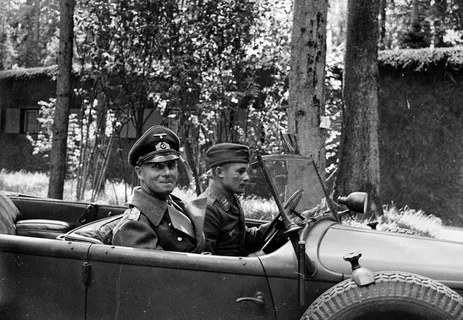
Rommel Open top Vehicle
Joseph Goebbels’ diary entry of November 24, 1944 provides evidence of Rommel’s participation in the resistance against National Socialism:
“Stülpnagel has provided the evidence that Field Marshals Kluge and Rommel were involved in the putsch planning of July 20, even if not in the assassination attempt against the Führer. I think we can thank fate that both passed away through death.”
– Joseph Goebbels
In a letter to his wife dated July 24, 1944, Rommel expressed his disapproval of the failed assassination attempt: “Regarding my accident, the assassination attempt on the Führer shook me particularly badly. One can thank God that it went so well. It remains unclear whether he was presenting his true opinion or whether he was merely trying to exonerate himself with this document.
Lieutenant General Hans Speidel had joined Rommel’s Army Group B in April 1944 as chief of staff. Unofficially, he was supposed to win over Rommel to the resistance. In early July 1944, Hofacker also sent Caesar to Rommel to clarify whether he wanted to join the resistance. Hofacker’s cousin Stauffenberg had met Rommel on February 19, 1943 at the divisional command post near Sbeitla when he was a lieutenant colonel in the 10th Panzer Division in Africa. Hofacker, who led the attempted coup in Paris, was arrested and tortured after its failure. At the beginning of September, Speidel visited Rommel in Herrlingen and reported to him that he had been removed from his post as Chief of Staff of Army Group B. Rommel’s name was found in the documents of the former mayor of Leipzig, Carl Friedrich Goerdeler, who also belonged to the resistance. Overall, however, there is still a lack of clarity as to how the incriminating statements came about. This is not least due to the fact that the Wehrmacht leadership was definitely interested in eliminating Rommel. “Because of his steep career, his popularity and above all because of the favor he enjoyed with Hitler, he had many enemies in the Wehrmacht.”
After the war, Speidel, who, unlike von Hofacker, had also been arrested but not sentenced to death, published the book in 1944. A Contribution to Rommel’s Fate and the Fate of the Reich, in which he portrayed Rommel as a member of the resistance. Rommel’s widow published her husband’s notes in 1950 and also explained that her husband’s military self-image had prevented him from any political activities: “Throughout his career he was always a soldier and never a politician.” He was therefore not involved in the resistance.
Helmut Krausnick already counted Rommel in 1953, when the assassination attempt of July 20, 1944 was still controversial in West Germany, as a resistance to National Socialism. He writes that, beyond the military, Rommel ” also witnessed the undermining of the rule of law by the methods of the Gestapo, Hitler’s excessiveness in the human, military and state areas, his suppression of the churches and his policy of extermination against the Jews, his contempt for any real humanity in general”. worried. He had planned Hitler’s arrest and sentencing so as not to murder the dictator and make him a martyr, which other resistance fighters also supported. From the other people of July 20, 1944distinguishes the field marshal “no deviating inner attitude, but at most the time of his realization and the question of the form of elimination of Hitler as a person.”
Wistrich wrote in 1983 that Rommel “sympathized with the conspirators without taking an active part in the conspiracy himself”, but overall remained “undecided”. However, he assumed that Rommel was well informed about the plans. Reuth, on the other hand, ruled in 1987 that Rommel neither knew of the assassination plans nor was he won over to the resistance. He said that Rommel had agreed with the representatives of the resistance, Speidel and von Hofacker, with regard to the assessment of the military situation and, like them, had demanded consequences from the unfavorable course of the war for the Wehrmacht. “However, what they meant by ‘consequences’ was fundamentally different.” Rommel never thought of murdering Hitler.
In his 1997 essay, Reuth also states that “neither Hofacker nor Speidel Rommel definitely won over the resistance”. David Fraser supports Reuth’s assessment:” Rommel had always rejected the idea of killing Hitler, although he was now convinced of the need to end the war and recognized that this included eliminating Hitler.”Both Fraser and Reuth therefore do not see Rommel as an accomplice in the conspiracy against Hitler, but do recognize that the conspirators were clearly trying to win over the popular Rommel. From the mid-1990s, the entries about Rommel disappeared from the July 20 works. Portraits of the Resistance(edited by Rudolf Lill) and from the Lexicon of Resistance 1933–1945 (edited by Peter Steinbach).
In September 1944, General Heinrich Eberbach told other German officers that Rommel had spoken to him privately in favor of killing Hitler and those closest to him. Eberbach was a British prisoner of war in Trent Park in September 1944; the conversations tapped there were published for the first time in 2005. After the end of the war, Eberbach repeated his statements from 1944. The historian Sönke Neitzel sees no proof in Eberbach’s statements, but an indication of those of Maurice Philip Remy supported thesis that Rommel had been informed by Caesar von Hofacker about the planned assassination attempt on Hitler. In addition, Peter Lieb referred in 2013 to Generalleutnant Alfred Gause, who had written in his copy of Desmond Young’s biography “Rommel: Der Wüstenfuchs” (1950) that it was not true that Rommel did not know about Valkyrie. In 2010, military historian Jörg Echternkamp reiterated in a popular scientific work the well-known thesis that Rommel’s role as a resistance fighter in 1944 was limited to the fact that he “wanted to make a separate peace with the western allies, but only to win the war in the east against the Red Army.” Apparently the conspirators also intended him to play the role of “opening” the western front together with Kluge if the assassination attempt was successful.
According to the military historian Gerd R. Ueberschär,”a constant change that can be observed as early as 1941, but no later than the end of November 1942 in connection with the demanded evacuation of North Africa” of Rommel’s from a supporter to an opponent of Hitler “is largely accepted in research”, as is the recent biographies by Sir David Fraser and Maurice P. Remy. Since 1943 Rommel had had a “distant and critical attitude towards Hitler and his conduct of the war” and “through v. Hofacker knew about the deliberations on the coup d’état.
According to the military historian Peter Lieb, a memorandum by Martin Bormann dated September 28, 1944, a diary entry by Joseph Goebbels dated November 24, 1944, and other evidence indicate that “Rommel not only knew about the July 20 coup, but also supported it and had switched to the camp of the conspirators.” He joined the resistance movement very late and played no role in the preparations for the assassination. Rommel is therefore not to be assigned to the inner circle of the people of July 20, 1944, but was more than just a sympathizer and paid for it with his life. “So you have to give him a permanent place in the military to concede resistance to National Socialism – to a greater extent than has been the case in historical studies and in the public sphere in recent times.”
After evaluating other sources, Lieb came to the same conclusion in 2018. He refers to statements by General Heinrich Eberbach that Rommel specifically addressed him Eberbach during the Battle of Normandy about the fall of the Nazi dictatorship; on documents from the Parisian conspirator Rudolf Hartmann, who described Rommel as the “bearer of the resistance” in France; and on Bormann’s memos that Rommel “was well informed” about the coup d’état and would be “at the disposal of the new government after the successful assassination attempt”. “The fact that Hitler gave the popular Rommel the option of a court hearing without incriminating evidence being available seems implausible,”said Lieb. This alone speaks for Rommel’s support for the resistance. It remains unclear “what specific role Rommel was intended to play during and after the assassination.”
Suicide and State Funeral
After a phone call the day before, General Wilhelm Burgdorf, Chief of the Army Personnel Office in the Army High Command and Head of the Adjutant Office of the Wehrmacht High Command under Hitler, and General Ernst Maisel, Head of the Office Group for Disciplinary Matters for Officers in the Army Personnel Office, arrived in Herrlingen on October 14, 1944. They presented Rommel with the supposedly incriminating material and gave him the alternative of killing himself or answering to the People’s Court. True, Rommel was convinced that this was an intrigue must act, yet he did not resist. He drove with the two generals in the car to beyond the town limits of Herrlingen, where he committed suicide with the help of the cyanide ampoule the generals had brought with them. Rommel’s wife was subsequently told that her husband had become unwell during the journey and that he eventually died of complications from an embolism.
However, these circumstances did not prevent the regime from covering up the actual circumstances of his death in order to effectively use the dead Rommel for propaganda purposes. The press only reported about Rommel’s injury in a low-flying attack with a considerable delay, namely on August 3, 1944: “On July 17, Field Marshal Rommel died in a car accident in France as a result of an air raid, resulting in injuries and concussion. His health is satisfactory. There is no danger to life.”The air raid was not mentioned at all when the death was reported on October 18, 1944, because the aura of the invincible soldier was not to be tarnished: “General Field Marshal Rommel is suffering from a severe head injury which he suffered as the commander-in-chief of an army group in the west in a motor vehicle accident, deceased.”
Rommel’s funeral service took place on October 18 in Ulm City Hall as part of a state ceremony that Rommel, according to his son, had negotiated. Gerd von Rundstedt held the eulogy. His body was then cremated, and the urn was later buried in the cemetery of St. Andreas Church in Herrlingen, in the municipality of Blaustein.
Hitler’s order of the day honored Rommel with the words: “In the present fateful struggle of the German people, his name is the epitome of outstanding bravery and fearless daredevilry.”
Gerd von Rundstedt stated in his eulogy: “The leader and supreme commander of the Wehrmacht called us here to say goodbye to his Field Marshal, who remained on the field of honor. With General Field Marshal Rommel, that great military leader has left us, such as is rarely given to a people. Deeply rooted in German soldiering, his life was dedicated exclusively to work and the fight for the Führer and the Reich,” and concluded with the words: “His heart belonged to the Führer.”
Propaganda Figure Rommel
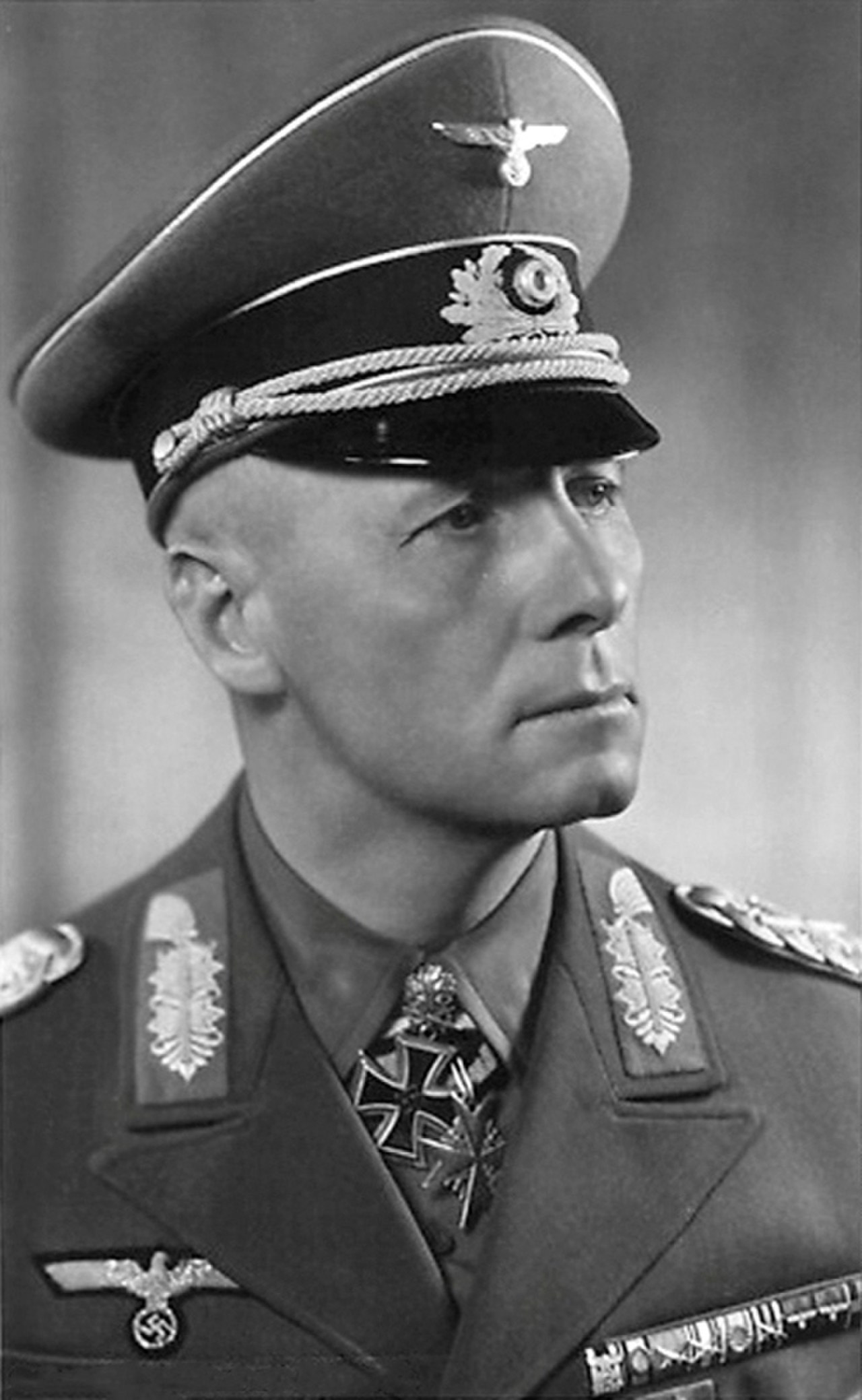
Rommel Portrait
Rommel was deliberately built into a Nazi propaganda figure and “liked to be portrayed as a legendary troop leader by Goebbels and his propaganda”. He was extraordinarily ambitious and, as a member of the military, saw himself bound to absolute loyalty to those in power to whom he had taken the oath of leadership. Added to this was his military talent and his special, often successful leadership style. He hoped that the propaganda surrounding him would boost his career. The close relationship with the dictator Hitler, which developed early on, was helpful, and he was considered his “favorite general”. Hitler, who otherwise strictly controlled the publication of images of his army leaders and generals, made an exception for Rommel. Minister of Propaganda Goebbels had a free hand to develop Rommel into a propaganda figure who embodied all the virtues that, according to the Nazi understanding, made an ideal soldier. There were also very specific personal connections between the Ministry of Propaganda and Rommel’s staff, for example in the form of Karl Hanke and Alfred-Ingemar Berndt. Goebbels gave Rommel a camera (Leica IIIc) with which he could record his missions in France and Africa. Rommel enthusiastically used this opportunity for self-portrayal, the results of which were partly published in Germany. Goebbels commented that “there is hardly a general who was as imbued with the importance of the propaganda mission as Rommel. The fact also testifies to how open-minded, modern general he is in the best sense of the word.”Rommel’s successful breakthrough of the Maginot Line in the western campaign in France (June 1940) was filmed in the same year under the title “Victory in the West” by the Ministry of Propaganda at original locations. The film had its premiere in February 1941 in Berlin ‘s Ufa-Palast am Zoo.
After Rommel’s deployment in North Africa, the Allies now also praised his skills as an army commander. The British Prime Minister Churchill mainly tried to explain to his own public why the British troops in North Africa had not yet won despite their military superiority. In fact, according to the British historian Antony Beevor, Rommel acted rather recklessly from the outset in his military decisions and ultimately only gained a great reputation because the Allied propagandists had an interest in stylizing him as a capable general in order to compensate for his incompetent actions of British military leadership in North Africa.
The Ministry of Propaganda even published a curriculum vitae of Rommel, which was adapted to National Socialist ideals, for the attention of the foreign press. Rommel was accused of coming from the working class and assumed membership in the SA and NSDAP. Rommel unsuccessfully protested against these falsifications.
Rommel’s popularity abroad was demonstrated in a 1942 Gallup poll: after Hitler, Rommel was the world’s best-known German. Goebbels noted this in his diary in February 1942: “Rommel continues to be the declared favorite object even of the enemy intelligence services.”
To avert damage from the carefully staged propaganda figure Rommel, Rommel was recalled from North Africa before the foreseeable defeat. Rommel’s subsequent transfer to the Atlantic Wall should give the population the same certainty of victory as it had in relation to North Africa. However, the injury he suffered in an Allied low-flying attack on July 17, 1944 did not fit the image of an invincible and honorable German soldier and was therefore presented as the result of a car accident. Speculations in the foreign press that Rommel had died were met with a press conference in Paris on August 1, 1944, at which Rommel faced the press for the last time.
Aftermath
Rommel’s assessment as an apolitical, brilliant commander and victim of National Socialism is sometimes referred to as the “Rommel myth”, which shapes the image of the field marshal to this day. His reputation for clean warfare was used in the post-war period in the interests of rearmament in the Federal Republic and reconciliation with Germany’s former wartime enemies, Great Britain and the USA. His person is viewed less critically than other representatives of the Wehrmacht, although he reached the peak of his career during the National Socialist era and had an ambivalent relationship to the resistance would have. It is still associated with ideas of an honorable and “knightly” fight, of a “clean Wehrmacht”. His mission in North Africa is particularly important. The fact that this theater of war was far removed from the deportations and death camps of the East made it easier to uphold the image of an immaculate soldier. The honesty of his mission in North Africa was also emphasized by his wife, who published her husband’s war records in 1950 under the title War Without Hatred.
Rommel’s relationship to the resistance, which has been repeatedly discussed, also contributes to presenting Rommel in a positive light. After the war, groups such as the “Verband Deutsches Afrika-Korps eV” and the “Rommel Sozialwerk eV” emerged. In addition, the first Rommel biographies were published by Englishmen, for example by Desmond Young, who himself had fought against Rommel in North Africa.
Honors
The Bundeswehr honored him in 1961 by naming the Field Marshal Rommel Barracks in Augustdorf and in 1965 with the Rommel Barracks in Dornstadt near Ulm. The Rommel barracks in Osterode am Harz have since been closed. In 1969, the German Navy christened a Lütjens-class destroyer the Rommel. His widow performed the baptism. The ship was decommissioned in 1998.
Numerous streets in German cities, especially in Baden-Württemberg, are named after him, for example in his last place of residence Blaustein-Herrlingen the Erwin-Rommel-Steige, formerly Wippinger Steige, on which his home at the time is located. In Erlangen, a student residence is named after the adjacent Erwin-Rommel-Strasse.
On November 12, 1961, a monument was erected in honor of Rommel on the Zanger Berg in Heidenheim. The keynote speaker was Hans Filbinger. At the beginning of the 2010s there was an extensive debate in Heidenheim about whether the Rommel monument should be demolished without replacement or replaced by a memorial or redesigned in some other way. A counter -memorial was erected in 2020 to commemorate the victims of the North Africa campaign, specifically those killed or maimed by landmines in North Africa.
The Rommel Museum was opened in 1989 in Herrlingen near Ulm in Baden-Württemberg, but in 2018 it was converted into a museum dealing with German history in general. Nonetheless, there is still a room in the museum devoted to Erwin Rommel.
From December 18, 2008 to August 30, 2009, the exhibition “The Rommel Myth”took place in the House of History Baden-Württemberg in Stuttgart.
Decades after the end of the war, veterans of the African campaign, including former opponents of the war, continued to gather at Rommel’s grave in Herrlingen, mainly on anniversaries of his death. In addition to the Federal Ministry of Defense, the US Army also laid funeral wreaths at the grave.


